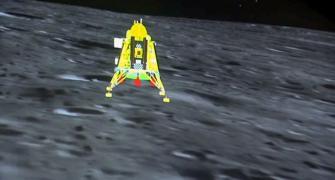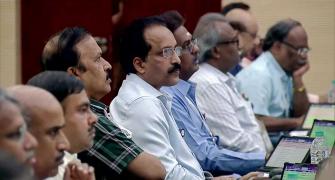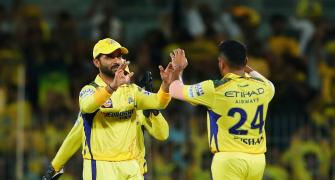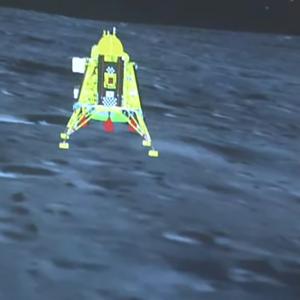'You declare a date, time and place for the landing two months in advance and exactly at that moment, it touched on the moon.'
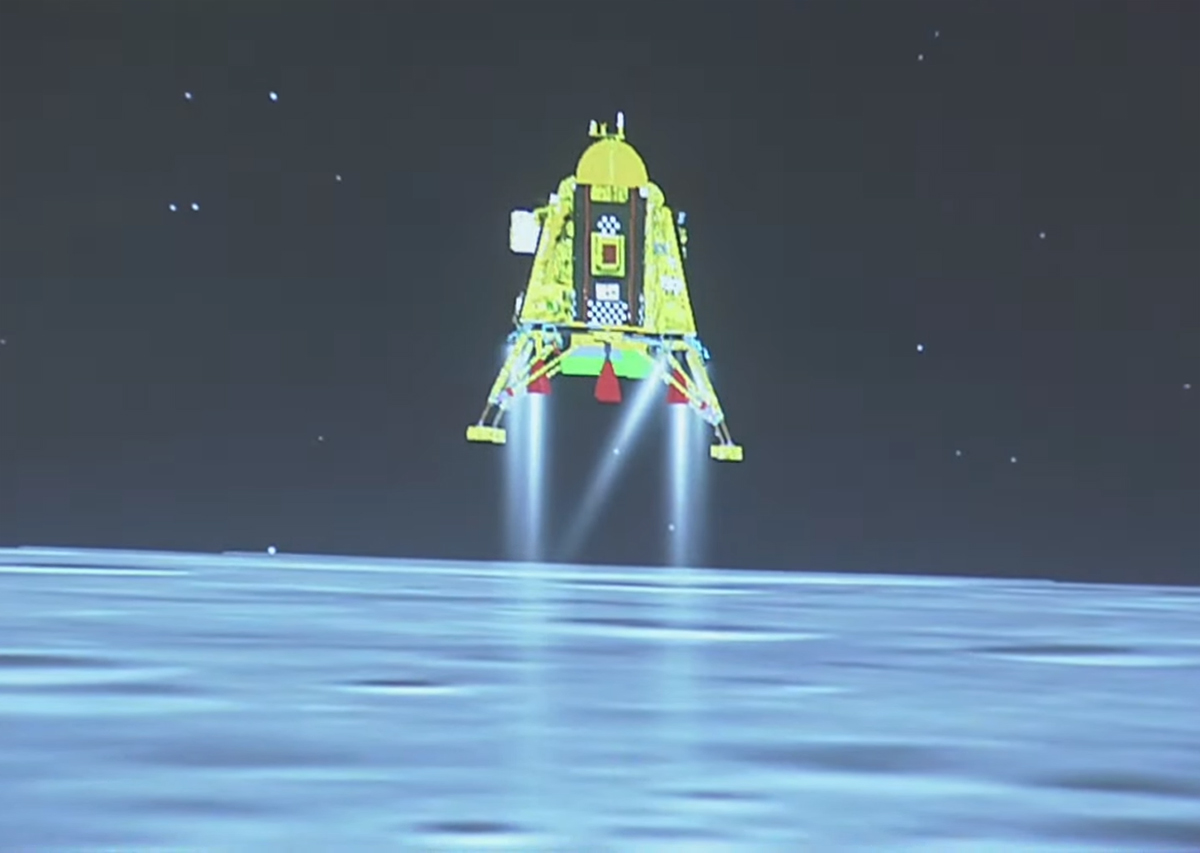
Chandrayaan-1, India's first mission to Moon, was launched on the 22nd of October 2008. And G Madhavan Nair was the chairman of ISRO then.
It was a successful mission.
Chandrayaan-2, launched in 2019 consisted of a lunar orbiter, the Vikram lander and the Pragyan rover. Unfortunately, it failed to have a soft landing on the south pole of the moon.
Chandrayaan-3 landed on the polar region of the moon on Wednesday, August 23, 2023.
"What we had put on the drawing board in those days, my followers have succeeded in accomplishing it. So, I was really thrilled and excited by the event," G Madhavan Nair tells Rediff.com's Shobha Warrier.
What was going through in your mind when you saw Vikram the lander successfully land on the south pole of the lunar region?
In fact, way back in 2005 itself, we were dreaming of this event; how to touch down on the moon.
Of course, we were not able to make a soft landing for Chandrayaan-1, but we deposited our flag there.
Since then, it was our wish that we should be able to land on the surface of the moon, collect the samples and bring them back.
So, it was something like a dream come true moment as far as I am concerned.
What we had put on the drawing board in those days, my followers have succeeded in accomplishing it. So, I was really thrilled and excited by the event.
In your book, Rocketing Through the Skies: An Eventful Life at ISRO, you have written about how the idea to deposit the Indian flag came about...
The spacecraft was almost getting ready when A P J Abdul Kalam, the then President of India, asked me a simple question, 'Don't you think you should leave a permanent mark on the moon when you go all the way up there?'
I told him, 'Today's technology and capabilities are limited. Not only that, the payload's capabilities are also limited. So, it will be difficult...'
Though I spoke about the difficulties to him, after coming back, we brooded over it. Then, a bright mind came with the idea that we could do something like throwing a stone to the moon surface from the orbiter.
So, we came up with something like a capsule which can be thrown from the orbiter to the moon.
Of course, it would be impacting with a high velocity which would result in it breaking into pieces.
So, we had its panels painted with our Tricolour on it. The idea was, even after a break up, the Tricolour would on the surface of the moon.
That was how we designed the Moon Impact Probe (MIP) to be carried aboard Chandrayaan-1.

How do you compare these three Chandrayaan missions?
In those days, moving out of the earth's orbit itself was a big challenge.
We mastered the technology in Chandrayaan-1. Also, all the mission calculations, trajectory and tracking were established during Chandrayaan-1.
But most of the observations were done through remote sensing camera, hyper spectral imaging, etc.
We received those signatures on the ground and it was by looking at the data that we confirmed the presence of water in the polar region and also the presence of helium-3.

Which was unknown to the world till then?
Yes. Though there were several missions from other countries, we were the first to announce to the world that there was water in the polar region.
That was a major achievement of Chandrayaan-1.
Also, we identified the locations where Helium-3 was in plenty.
We also did the mapping of other minerals, elements and ice.
Then, a high resolution map of the lunar surface with its craters, mountains, etc was generated during Chandrayaan-1.
I would rate Chandrayaan-1 was 100% successful.
In the case of Chandrayaan-2, it was to be a follow-on of Chandrayaan-1.
We wanted to confirm the observations we made through remote sensing parameters, were accurate and could be validated.
Chandrayaan-2 was planned very similar to Chandrayaan-1 with the orbiter.
But the landing module would carry a rover that would land on the surface of the moon and pick up samples from the surface.
Unfortunately, just 2 kilometres away from the surface of the moon, it developed some problems, and the mission did not fully succeed.
But the orbiter is still alive. In fact, that will be used as a relay station for Chandrayaan-3.
In short, we will be using the Chandrayaan-2 orbiter as a backup communication link between the Chandrayaan-3 Vikram lander and the ground stations.
I would say, Chandrayaan-2 was 95% successful.
Now, in the case of Chandrayaan-3, corrective measures were implemented based on whatever failures that had happened to Chandrayaan-2.
It was re-validating the technology. Of course, its failure gave a lot of valuable lessons on how to manage a mission on the lunar surface.
Those lessons were put in the action plan by making design changes, strengthening the instruments, etc.
Chandrayaan-3 was fully tested and calibrated based on the changes.
Finally, we saw text book precision in its performance.
You declare a date, time and place for the landing two months in advance and exactly at that moment, it touched on the moon. This is what is text book precision!
It was a remarkable achievement.
Now, the Rover has moved out of the capsule, and it will be going around taking samples and sending the data back to us.
That will be a reconfirmation of whatever observations we had made earlier.

Which was the most challenging part of Chandrayaan-3 mission? Was it moving from horizontal to vertical position, or reducing the speed from 6000 km per hour to zero before landing, or soft landing...
We have gone around the moon earlier also. This is the third time we are doing it. So, it was a proven technology for us.
Whereas, breaking from the lunar orbit and landing on the surface of the moon is the most challenging and crucial part of this mission.
And everything is controlled by the onboard computer.
Does that mean, once the spacecraft is out there in the space, you have no control over it?
Yes, there is no intervention possible from the ground. It means whatever we have planned and simulated onto the onboard computer has to be perfect.
Only then the mission can be achieved.
Finally, when the Rover was above the surface of the moon, it looked at the location whether it was suitable or not and then decided to have the landing carefully.
The entire operation was done by the onboard computers.

Man landed on the moon way back in 1969. Why is it that no country looked at the south pole of the moon till now?
Why did it remain a dark area for so long?
In those days, the technology was limited, the power of the type of tracking equipments were limited... With all those limitations, we were able to reach only the region of 20 degree latitude.
And people were concentrating on that region.
Once the presence of water is confirmed in the polar region by us, there has been a lot of interest in the south pole.
Because of the presence of water, what are the possibilities available for future missions to the polar region?
For life support, water is the most essential element.
In addition, you can have a base there if you want to have inter-planetary travel since oxygen and hydrogen can be generated from water.
You can learn more about other planets with this region as the base.
You can also study how the moon has originated.
Also, you can find out about the minerals, contents of the ionised particles and the rare elements that are there. This knowledge will be very useful to mankind.
It is also interesting to study whether any seismic vibrations occur on the moon like what we see on earth.
The possibilities are a lot...
Feature Presentation: Aslam Hunani/Rediff.com

